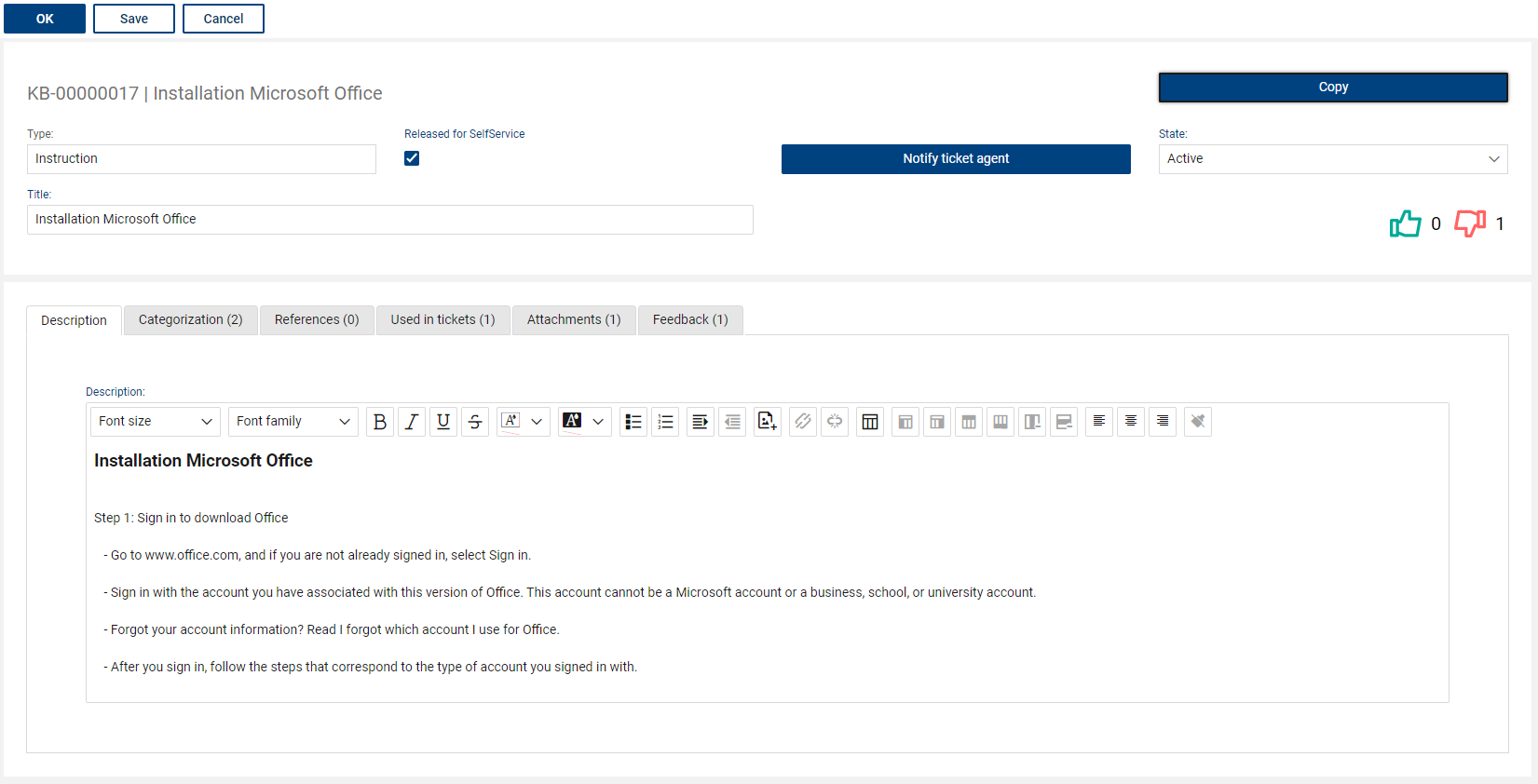The knowledge base manages all entries and articles provided to an end user in the SSP or to a user for ticket solution research or general information.
The following fixed default types are available for new entries "Knowledge base entry types":
•Knowledge base entry: General articles for the management of knowledge base entries (general technical descriptions, publication of generally interesting articles, etc.).
•Instruction: Management of specific instructions for the setup or use of hardware and software products or other operating instructions or instructions for use.
•Standard solution: Solution instructions for frequently occurring tickets in order to be able to provide a solution quickly.
•Workaround: If the cause of an incident cannot be eliminated quickly, a temporary workaround for the problem can be described and a work instruction for it can be stored. As soon as the cause has been eliminated, the workaround can be replaced (e.g., by a standard solution). The provision of a workaround is carried out by "Problem Management" in accordance with ITIL®.
•Known error: If the error is already known but not fixed, you should create a known error and link it to the corresponding problem ticket. This serves to the exact documentation and the prevention of many reported tickets. The provision of a known error is done— according to ITIL®— by the "Problem Management". This allows the problem manager to track at any time which problems refer to this entry and, if necessary, which tickets are affected by it and communicate accordingly.
When creating a new entry in the knowledge base, the type of entry and a description must first be specified as mandatory fields.
|
Note: In order to support an uncomplicated and fast filling of the knowledge database, every user is authorized to create new entries. Entries can be made directly in the knowledge base or from tickets, including the transfer of solution descriptions at the push of a button, in order to quickly make solutions found available to other users. The release of entries (change of state from "New" to "Active" or "Obsolete") may only be performed by a user of the authorization group "Ticket Manager" or "AssetDB Manager", so that the administration is coordinated and e.g. multiple entries can be avoided. |
The following functions are provided by the knowledge base entry:

Header
An entry in the knowledge base can have one of the states "New" (in development), "Active" (released for active use), and "Obsolete" (no longer released for active use). Only users with the role "Ticket-Manager" or AssetDB Manager" are allowed to activate (=release) entries so that they can be used in tickets. A free text field allows to enter a short title.
The "Notify ticket agent" button is only visible in the "Active" state and sends a standard e-mail to all system users of the "Ticket editor" group with the information on the knowledge base entry. The function can be used if a new or changed entry has been released, and the ticket editors are to be informed about it proactively.
The "Show in SelfService" function displays the title, type, description, and attachments of the knowledge base object in the Self-Service Portal as well.
In addition, it is possible to copy an existing entry by clicking the corresponding button in order to create a new version of the entry, if necessary, without overwriting the existing entry. This function is useful when different software versions are used in parallel, with a corresponding solution variant for each version.
Section "Description"
This tab contains the main description of the record, with an rich text field including the opportunity to embed pictures.
Section "Categorization"
In the "Categorization" section, links to one or more categories from the category tree can be created. This way, the entry is stored in the appropriate category and can be found more quickly via category searches in the Self-Service Portal, among other places, or is displayed to the ticket agent as a suggestion if a category matches in the ticket.

Section "References"
Under "References", relationships can be established between entries in the knowledge base. This may be used to find related entries (e.g. descriptions for the same solution manual for other software versions) or earlier/newer versions of an entry. Furthermore, all tickets that are linked to this entry are listed here. It is also possible to link further tickets from this location (e.g. in case of a found workaround) so that the ticket processor can see this information directly in the ticket.
Section "Attachments"
In the "Attachments" section, any attachments up to 10 MB each can be attached to the article. The attachments are accessible only to internal users and are not visible in the Self-Service Portal.
Section "Feedback"
In the "Feedback" section, a feedback note can be written for an entry (internal) and an article can be rated as helpful or not helpful (internal and external in the Self-Service Portal).
Each user can only give one rating per article.
